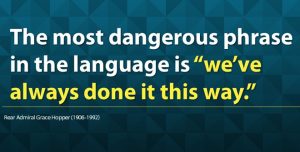
What if I told you that you had at your fingertips an army of potential brand ambassadors who could take your visibility and credibility to astounding new heights … if only they had the information and a little nudge?
Guess what? You do. And they’re right down the hall.
Your company’s employees — from the CEO to the mailroom folks — could be your content marketing plan’s biggest untapped asset.
Now, what if we had a tool that let us inform and engage them on a daily basis? Again, you do, and it’s called your intranet.
True, the intranet has traditionally been the territory of our colleagues in the human resources department, as they hold much of the information that needs to reside there. But remember, they’re not marketers. By setting up a strategic alliance that leverages HR’s knowledge and the content marketing team’s panache for informing, educating, informing and entertaining through content, we can take our internal communications to exciting new heights.
Smart brands like Nokia and Target have transformed their intranets from yawn-worthy bulletin boards to interactive, engaging employee hubs. If you’re ready to mobilize your employees to take up your brand’s flag, it’s time to learn the 7 Habits of Highly Successful Intranets and put them into action:
1. They’re audience-focused.
Ever seen an intranet that’s nothing more than a dumping ground of random documents and updates, with no thought behind any of it? I sure have.
The reason for this foible is that far too many companies approach their intranets with the question “What do we want to tell our employees?” when they should be asking “If I were Average Joe Employee at Whizbang Widgets, what would I want in an online hub?”
Remember, as content marketers, we start by getting to know our audiences, and we let that information inform the rest of our strategic planning. Internal content marketing is no different: we need to get laser-focused on who that internal audience is (and no, “our employees” won’t’ cut it) and create a strategy around delivering the right content, at the right time and in the right format, for engaging and delighting them.
Action Item: Create clear personas for each audience your intranet addresses, and use that knowledge to guide your content.
2. They’re written by humans, for humans.
Another reason why so many intranets fail to engage is that they’re badly written — really badly written. Dry, robotic, approved-by-five-different-committees corporate-speak infuses every line, and management wonders why employees aren’t using this “outstanding resource.”
Again, if we’ve done our jobs as content marketers and gotten to know our audience, we’ll get a good idea of the best voice to adopt in our internal content. Sure, we don’t want to be too casual (if I ever hear of you using the word “bae” on your intranet, I will hunt you down and confiscate your keyboard), but a friendly voice — like one you might hear around the water cooler — will go a long way.
Action Item: Spend some time and effort determining the best voice for your internal content, and include it in your internal content style guide.
3. They’re useful.
As we all know, the best content marketing solves a problem for your audience, and internal audiences are no different.
Employees need information from you. They need to know whether they get Christmas Eve off this year. They need the open enrollment documents for their benefits packages … and they need to know the deadline. They need to know that Taco Tuesdays are back in the cafeteria. They need to know who the new CFO is.
A successful intranet puts all these basic “need to knows” at employees’ fingertips — and much more. Share productivity tips to help them blast through their to-do lists. Publish a checklist to help them write more effective emails. If a large percentage of your employees travel for work, embed forecasts and travel advisories to help them prepare for their next sojourn.
First and foremost, your internal team must trust your intranet as a source of current, useful, accurate information. Once that trust is established, we can move on to the business of engaging them in our mission to spread our message.
Action Item: Before you try to get fancy, make sure your intranet is delivering the information employees need and want from you.
4. They’re well organized.
There’s an old adage in sales that goes “a confused customer will never buy.” To repurpose that idea for your intranet, a confused employee will never click … and may never return.
The larger your organization is, the more tightly organized your intranet content has to be. We organize our public websites according to what the visitor needs, and we must do the same for our intranets. A great way to do this is through card-sorting exercises, where you ask a user (from any department) to sort cards marked with topics into the arrangement that makes sense to him or her. You might be surprised at the results.
Action Item: Work with internal focus groups to determine the best way of organizing your intranet content.
5. They’re interactive.
As content marketers, we understand that if we’re going to reach people, we need to “put down the bullhorn and pick up the telephone.” We can no longer get away with talking at people; we need to talk with them. Internal content marketing is no different.
Don’t settle for an intranet that’s just an online version of the old paper employee newsletters. Engage your audience with polls, quizzes, games, and opportunities to share their points of view. As an added bonus, you can also get some valuable ideas for your external content. Winning!
Action Item: Gather your team and explore ways to make your intranet content more interactive.
6. They’re visual.
“Words, words, words,
I’m so sick of words!
I get words all day through,
First from him, now from you;
Is that all you blighters can do?”
– My Fair Lady
I agree, Eliza. Your employees read words on paper (or screen) all day long, so liven things up a bit by presenting some of your intranet content in visual formats. Think infographics, videos, slideshows … and remember to share those all-important photos from last week’s company picnic.
Action Item: Explore ways to incorporate videos, infographics, photos, and other visual elements into your intranet content.
7. They’re fun.
“Fun? Whaddya mean, ‘fun?’ We’re here to provide information, not to entertain!”
Thus spoke the old-school intranet manager — the one who hasn’t yet caught on to the power of internal content in creating powerful brand ambassadors. Today’s leaders realize that the mission of their intranet is to engage, and yes, an element of fun fits right in with that objective.
Work can be stressful, so give your team something to smile about, even if it’s for just a few seconds. Share funny stories, cartoons, and videos — like Tripp and Tyler’s hilarious parody “A Conference Call in Real Life” — or invite team members to share their own funny content. (Of course, we need to keep it clean and steer clear of insensitive jokes … but you already knew that.)
Action Item: Explore ways to add (responsible) humor to your intranet content on a regular basis.
Power Up Your Intranet with Powerful Content
So, now you know the 7 Habits of Highly Effective Intranets … now, where do you start? First, meet with your colleagues in human resources to share your vision and get them on board. Then plan the project as you would a new website, complete with user personas and best practices from user experience, content strategy, and of course, content marketing.
Digital & Social Articles on Business 2 Community(71)





